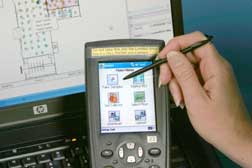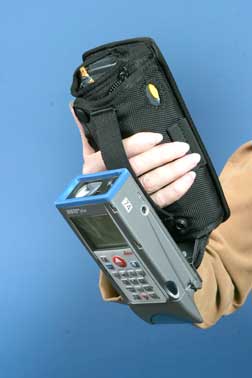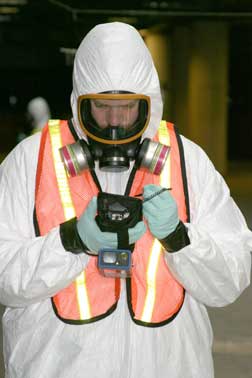NEWS RELEASES
FOR IMMEDIATE RELEASE
June 7, 2006
Sandia tool speeds up environmental cleanup, reopening of contaminated facilities
BROOM software now available to potential licensing partners
 Sandia’s BROOM system includes a personal digital assistant
(PDA) application that allows users to generate precise contamination
maps and sample locations. The application runs on the Pocket
PC operating system and makes use of a Bluetooth-controlled laser
range finder.
Sandia’s BROOM system includes a personal digital assistant
(PDA) application that allows users to generate precise contamination
maps and sample locations. The application runs on the Pocket
PC operating system and makes use of a Bluetooth-controlled laser
range finder.Download 300dpi JPEG image, “broom-pda.jpg,” 516K (Media are welcome to download/publish this image with related news stories.)
LIVERMORE, Calif. — A software-based tool developed by Sandia National Laboratories for managing the collection, visualization, and analysis of environmental sampling data is now available to potential licensing partners.
Sandia’s Building Restoration Operations Optimization Model (BROOM) software system was developed to help decision makers — during the planning phase and throughout actual cleanup operations — to speed up reoccupation and return to service of contaminated buildings and facilities. The tool provides an efficient and scientifically defensible approach to planning and executing sampling and cleanup activities. To date, there has been no comprehensive system for handling and assisting with this process.
Sandia is a National Nuclear Security Administration laboratory.
Many potential users, applications
Originally developed for use during cleanup of facilities following a bioterrorism attack, BROOM is easily adapted to other spatial domains where accurate and efficient data tracking, management, optimization, and analysis of samples are needed. Possible users and/or applications of BROOM include:
- Environmental cleanup (including Superfund sites)
- Remediation companies
- Industrial hygiene
- Forensics/crime units
- Incident characterization
- Decontamination contractors
- Health agencies
- Airports, subways
- Government buildings
- Ports of entry
- Water utilities
- Gas and electric utilities
- Chemical plants
- Other critical infrastructure facilities
 An
important accessory to BROOM’s PDA device is a Leica DISTOª Plus
laser range finder. The wireless laser range finder maps
out with pinpoint accuracy the location from where samples
are taken.
An
important accessory to BROOM’s PDA device is a Leica DISTOª Plus
laser range finder. The wireless laser range finder maps
out with pinpoint accuracy the location from where samples
are taken.Download 300dpi JPEG image, “broom-rangefinder.jpg,” 696K (Media are welcome to download/publish this image with related news stories.)
Cost, efficiency savings could reach into multi-millions of dollars
The cost to shut down public facilities, plants, or businesses can be enormous. According to Business Week, costs of the 23-day closure of Ronald Reagan National Airport in Washington, DC after the 9/11 attacks have been estimated at $330 million per day to the airport and Northern Virginia businesses, and $27 million to state and local tax revenues.
Costs to clean up the Hart Senate office building after an anthrax-laced letter was discovered were originally estimated at $5 million, but ballooned to $28 million. The Hart cleanup took three months and involved collecting and processing more than 10,000 air and surface samples. Moreover, lost revenue estimates for an anthrax attack at a busy airport approach nearly $30 billion. Increasing efficiency in cleanup operations by using electronic data collection, sample management, and streamlined analysis processes could significantly impact the bottom line for cleanup efforts and related economic factors.
BROOM’s integrated data collection, fast and efficient data management, and easy-to-use visualization software provides the ability to manage information needed to help assess contamination within a facility, most effectively and efficiently plan operations to remediate that contamination, complete the clean up, and restore the facility to operation.
BROOM improves the efficiency of cleanup operations, minimizes facility downtime, and provides a transparent basis for reopening. The last factor is critical in gaining public and regulatory acceptance for declaring a facility to be “clean” and safe to reoccupy.
 BROOM
research has included demonstrations and exercises with San
Francisco International Airport and other model facilities.
Here, a technician outfitted in HazMat gear enters sample
information into the BROOM PDA device.
BROOM
research has included demonstrations and exercises with San
Francisco International Airport and other model facilities.
Here, a technician outfitted in HazMat gear enters sample
information into the BROOM PDA device.Download 300dpi JPEG image, “broom-bio-restore-demo.jpg,” 828K (Media are welcome to download/publish this image with related news stories.)
Sophisticated yet easy-to-use hardware
“Collecting samples from a contaminated facility is currently a painstaking, time-consuming process for HazMat responders,“ says Jane Ann Lamph, a Sandia engineer and business development associate leading the BROOM commercialization effort. BROOM makes the procedure far more efficient and accurate, she said, with the aid of a handheld device, easy-to-use software, scanner, and wireless laser range finder that maps out with pinpoint accuracy where samples are taken.
The centerpiece of BROOM is a handheld device, which looks like a typical PDA but packs a large amount of data and information. The device uses sophisticated algorithms to generate contamination maps and layouts of the location where the responders are collecting samples and to develop statistically based sampling plans; a barcode scanner to track tagged samples and maintain chain-of-custody records; and electronic forms to capture information such as the sample type, surface type and texture, collection method, and other important data that is collectively managed by the BROOM software.
During time-sensitive events when sampling data is needed quickly, information can be wirelessly transmitted to a PC or central command station outside the contaminated area in a secure manner. The results can be displayed on a map on both the handheld device and the PC, allowing decision makers to determine if an area is truly clean, and to reopen facilities as quickly as possible.
The BROOM system is the result of a three-year development effort funded by the Department of Homeland Security. The research included demonstrations and exercises with San Francisco International Airport and other model facilities.
Sandia is a multiprogram laboratory operated by Sandia Corporation, a Lockheed Martin company, for the U.S. Department of Energy’s National Nuclear Security Administration. Sandia has major R&D responsibilities in national security, energy and environmental technologies, and economic competitiveness.
Sandia news media contact: Mike Janes, mejanes@sandia.gov, (925) 294-2447